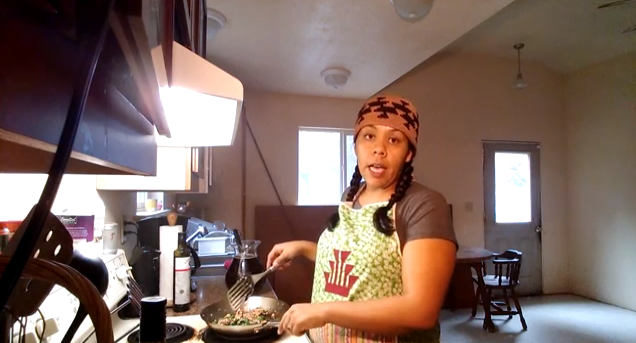When she posted a picture of kale and eggs to Facebook, people asked her how she made it.
From there, the brainstorm: Baldy launched her own YouTube channel -- Cooking Healthy in Indian Country -- to show people how to cook easy, nutritious meals for their families.
People who might have been suspicious of kale and beets can learn how to make a stir-fry of local Trinity River salmon, trumpet mushrooms and a side of kale or beet pancakes, complete with a strawberry and honey sauce.
“When I developed the show, it was mainly to say that our local vegetables are not hard to use,” Baldy said. “I like to take comfort food and add these vegetables.”
On YouTube and Facebook, she’s taught viewers how to make creamy kale and artichoke dip, black bean salsa, chard tacos and kabocha muffins. She also featured a venison stir-fry.
Baldy cooks with traditional Hupa foods – deer, salmon, berries and mushrooms – to encourage the American Indian community to integrate them back into their diets.
“I really emphasize native and traditional foods because why do we have high diabetes and high heart disease rates?” she said. “As native people, we sustained on a traditional diet for thousands of years. Acorns are high in fiber, which we now lack. Berries and roots are high in antioxidants, iron – stuff we desperately need that we aren’t getting.”
Humboldt County as a whole has some of the worst health outcomes of any of California's 58 counties. For Native Americans, the statistics are even worse. According to Humboldt County’s 2013 Community Health Assessment, the diabetes death rate for Native Americans is nearly triple that of whites in Humboldt County.
The diabetes prevalence rate in Hoopa is at 9.9 percent, according to the K'ima:w Diabetes Programin Hoopa. The program’s coordinator, Dr. Terry Raymer, said that number only accounts for the known cases.
“The high prevalence is due to a combination of loss of traditional culture and loss of traditional foods,” Dr. Raymer said. “There’s certainly some pretty good evidence that the chronic long-term effects of historical trauma has some impact on the prevalence of diabetes. It’s really quite complicated. It’s not just that people don’t exercise.”
Baldy’s show addresses the many causative factors and the complexity of diabetes in Hupa. In the videos, she explains the nutritional value of foods, naming their different vitamins and benefits. A collaboration of local health organizations help support the cooking show.
Baldy also emphasizes supporting the community. She often gives shout-outs to local farmers and artisans, showing off their handmade aprons and hats. One local elementary school teacher plays “Cooking Healthy in Indian Country” in her class.
“I definitely think nutrition needs to be more of an issue here,” said Amy Davis, who teaches sixth grade at Hoopa Valley Elementary, adding that Baldy helps shed light on issue in an interesting way to children.
At first the audience was local, but through social media shares and buzz in the American Indian community, Baldy has viewers nationwide. United Indian Health Services promoted her, and Good Health TV, a national American Indian and Alaska Native education network that promotes health literacy through programming, is about to pick up her shows.
But it's the comments on videos and compliments on the street that make her day, she says.
What’s on the menu next? A strawberry and kale salad and a strawberry spread with chia seeds.
